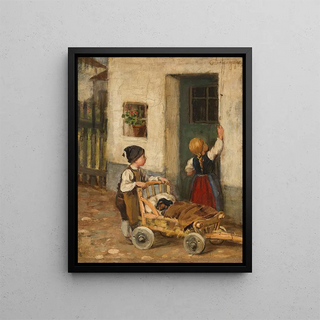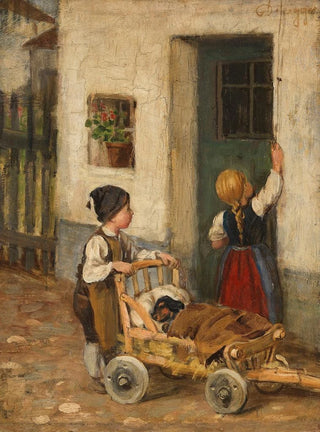Painting The Sick Dachshund - Franz von Defregger | Art print


View from behind

Frame (optional)
Introduction captivante
The artwork titled "The Sick Dachshund," created by Franz von Defregger, immerses us in a world filled with tenderness and melancholy. This painting, depicting a small dog with a sorrowful gaze, evokes deep and universal feelings, touching both compassion and vulnerability. The scene, seemingly simple, is nonetheless rich in emotion, capturing a moment of intimacy between the animal and its environment. Through this piece, Defregger manages to establish a strong emotional connection with the viewer, inviting reflection on the fragility of life and the beauty of fleeting moments.
Style and uniqueness of the artwork
Franz von Defregger's style is characterized by meticulous attention to detail and a color palette that evokes warmth and softness. In "The Sick Dachshund," earthy tones and subtle lighting contribute to creating a soothing atmosphere, while emphasizing the sadness of the subject. The way the artist renders the texture of the dog's coat, as well as the surrounding elements, demonstrates undeniable technical mastery. Each brushstroke seems charged with emotion, and the composition, though simple, is carefully orchestrated to guide the viewer's gaze toward the dachshund's face, the true focal point of the piece. This ability to capture moments of pure emotion is what sets Defregger apart in the artistic landscape of his time.
The artist and his influence
Franz von Defregger, born in 1835 in Austria, is an artist whose work has been greatly influenced by his love for nature and animals. Although he is often associated with scenes of rural life and portraits, it is his sensitivity towards animals that has allowed him to reach a broad audience. His realistic approach, combined with a touch of idealism, paved the way for a new appreciation of animal subjects in art. Defregger was able to capture the psychology of his subjects, whether human or animal, and his influence still endures today. Contemporary artists continue to draw inspiration from his style and his ability to convey deep emotions.

Matte finish

View from behind

Frame (optional)
Introduction captivante
The artwork titled "The Sick Dachshund," created by Franz von Defregger, immerses us in a world filled with tenderness and melancholy. This painting, depicting a small dog with a sorrowful gaze, evokes deep and universal feelings, touching both compassion and vulnerability. The scene, seemingly simple, is nonetheless rich in emotion, capturing a moment of intimacy between the animal and its environment. Through this piece, Defregger manages to establish a strong emotional connection with the viewer, inviting reflection on the fragility of life and the beauty of fleeting moments.
Style and uniqueness of the artwork
Franz von Defregger's style is characterized by meticulous attention to detail and a color palette that evokes warmth and softness. In "The Sick Dachshund," earthy tones and subtle lighting contribute to creating a soothing atmosphere, while emphasizing the sadness of the subject. The way the artist renders the texture of the dog's coat, as well as the surrounding elements, demonstrates undeniable technical mastery. Each brushstroke seems charged with emotion, and the composition, though simple, is carefully orchestrated to guide the viewer's gaze toward the dachshund's face, the true focal point of the piece. This ability to capture moments of pure emotion is what sets Defregger apart in the artistic landscape of his time.
The artist and his influence
Franz von Defregger, born in 1835 in Austria, is an artist whose work has been greatly influenced by his love for nature and animals. Although he is often associated with scenes of rural life and portraits, it is his sensitivity towards animals that has allowed him to reach a broad audience. His realistic approach, combined with a touch of idealism, paved the way for a new appreciation of animal subjects in art. Defregger was able to capture the psychology of his subjects, whether human or animal, and his influence still endures today. Contemporary artists continue to draw inspiration from his style and his ability to convey deep emotions.
12,34 €






